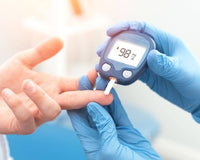Glyburide is a prescription drug that belongs to a class of medications called sulfonylureas. These medications work to lower blood sugar by causing the pancreas to produce insulin.
Glyburide is used with a proper diet and exercise program to control and lower blood sugar in people with type 2 diabetes. Controlling high blood sugar has been found to prevent kidney disease, strokes, heart disease, and heart attacks, among other conditions.
Glyburide Side Effects
There are a number of side effects associated with glyburide, most of which are relatively mild and should disappear within a few days.
Common Side Effects
- Stomach pain
- Low grade fever
- Cold chills
- Fever
- Hives
- Rash
- Itching
- Heartburn
- Vasculitis
- Joint pain
- Muscle pain
If these side effects are mild, they should disappear within a few days. If side effects persist, talk to your doctor or another healthcare professional.
Serious Side Effects
Some side effects of glyburide are more serious and may require medical attention. Call your doctor immediately if you begin to experience any of the following serious symptoms of glyburide. Call 9-11 if you think your side effects may be life threatening.
- Chills
- Clay-colored stools
- Abdominal pain
- Unpleasant breath odor
- Bleeding gums
- Back and leg pain
- Bloody or tarry black stools
- Depression
- Hostility
- Increased thirst
Glyburide Brand Name
Glyburide is available as a generic medication and as a brand name drug under the following brands:
- Diabeta
- Glynase PresTabs
Glyburide Dosage
Glyburide is available as an oral tablet at the following strengths:
- 1.5mg
- 3mg
- 5mg
- 6mg
Your dosage for glyburide can vary depending on a variety of factors including:
- Your age
- Your weight
- Severity of condition
Dosage For Type 2 Diabetes
Adult: 2.5 to 5mg per day.
Maintenance Dosage: 1.5 to 20mg daily. Consult with your doctor to determine exact dosage.
How To Take Glyburide
Take glyburide as directed by your doctor or another healthcare professional. Glyburide comes as a tablet that should be taken orally once a day. You should usually take glyburide during breakfast or another meal with water. Do not take glyburide without food or water.
Glyburide Mechanism Of Action
Glyburide works to lower blood sugar by stimulating the release of insulin from the pancreas. This is an effect dependent upon functioning brain cells in the pancreatic islets. During long term administration, the effects of glyburide have not yet been determined.
Glyburide Warnings
Taking too much glyburide
Low Blood Sugar Warnings
Glyburide can cause low blood sugar in certain people and situations. Common symptoms of low blood sugar may include:
- Shakiness
- Anxiety
- Confusion
- Intense hunger
- Nausea
- Headaches
- Weakness
Infection, Injury And Surgery Warning
If you have an infection, get injured, or have a major surgery, your doctor may stop your dosage of glyburide for a certain amount of time. Increased stress from these events can affect the ways in which glyburide works on your body. Always talk to your doctor before taking glyburide if you are injured or infected.
What Are The Interactions Of Glyburide?
Taking glyburide along with certain medications can result in serious negative side effects. The most common interactions of glyburide include metformin and glipizide.
Glyburide And Metformin
Glyburide and metformin are similar medications often confused with each other.
Glyburide causes your pancreas to release more insulin into the bloodstream. Metformin, on the other hand, reduces the absorption of sugar from the stomach, and helps your body use sugar effectively.
Glyburide vs Glipizide
Glyburide and glipizide are prescription medications that both work to stimulate the release of insulin from the pancreas. Glyburide, however, has been found to be more potent and clinically effective than glipizide.
Takeaway
Glyburide is a prescription medication that works to lower blood sugar by causing the pancreas to produce insulin. It is available as the brand name drugs Diabete and Glynase.








